If you want to know about the refuge area or toilet design or requirements for disabled persons in a building, please click the link.
A staircase design is a layout for a set of steps that connects different levels in a building. It can be made from various materials, such as wood, concrete, or metal, and can be decorated in different ways to match the style of the building. The design of a staircase involves several factors, such as the number of steps, the height of each step, the width of the steps, the size of the landing, and the angle of the handrail.
It’s important to consider safety and accessibility requirements when designing a staircase, such as ensuring that the steps are not too steep or slippery and that there is adequate space for people to move up and down the staircase.
- Stairs is a set of steps which give access from floor to floor.
- The room or enclosure of the building, in which stair is located is known as staircase.
- Staircase provide access & communication between floors in multi-storey buildings and are a path by which fire can spread from one floor to another.
- Therefore it must be enclosed by fire resisting walls, floors, ceilings and doors.
- It must be designed to carry certain loads, which are similar to those used for design of the floors.
- Stairs may be constructed of Timber, Bricks, Stone, Steel or Reinforced Cement Concrete.
1) Technical terms
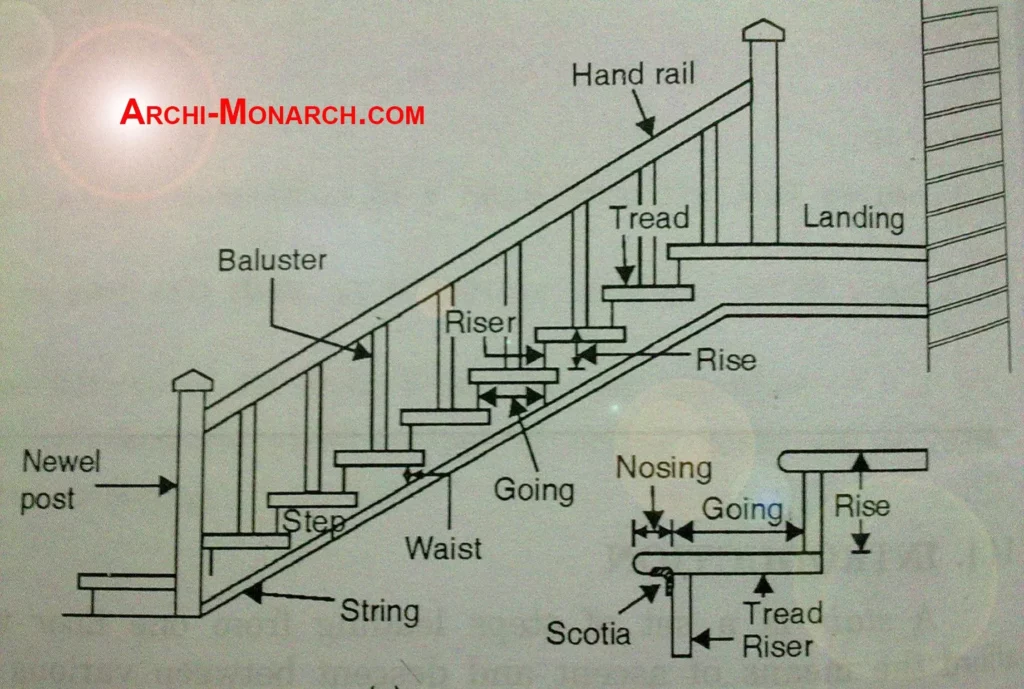
i) Step
- It is a portion of stair which permits ascent or descent. A stair is composed of a set of steps.
ii) Tread
- It is a upper horizontal portion of a step upon which foot is placed while ascending or descending.
iii) Riser
- It is a vertical portion of a step providing support to the tread.
iv) Landing
- It is level platform at the top or bottom of a flight between the floors.
v) Flight
- This is an unbroken series of steps between landing.
vi) Rise
- It is a vertical distance between two successive tread faces.
vii) Going
- It is a horizontal distance between two successive riser faces.
viii) Nosing
- It is the projecting part of the tread beyond the face of riser.
ix) Scotia
- It is a moulding provided under the nosing to provide strength to nosing.
x) Soffit
- it is the underside of a stair.
xi) Pitch or slope
- It is the angle which the line of nosing of the stair makes with the horizontal.
xii) Strings or stringers
- These are the slopping members which support the steps in a stair.
xiii) Newel post
- Newel post is a vertical member which is placed at the ends of flight to connects the ends of strings and hand rail.
xiv) Baluster
- It is vertical member of wood or metal, supporting the hand rail.
xv) Head room
- It is the clear vertical distance between the tread and overload structure.
2) Types of steps
- Flier
- Bull Nose
- Round Ended
- Splayed
- Commode
- Dancing
- Winders
i) Filer
- A filer is an ordinary step of uniform width and rectangular shape in plan.

ii) Bullnose step
- It is generally provided at the bottom of the flight , projecting in front of the newel post. Its end near the newel forms the quadrant of a circle.
iii) Round ended step
- It is generally provided at the bottom of the flight , projecting in front of the newel post. Its end near the newel forms the quadrant of a circle.
iv) Splayed step
- This step has one end or both ends splayed in plan.
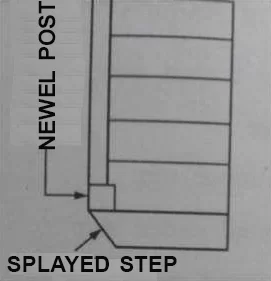
v) Commode step
- A commode step has curved tread and riser.
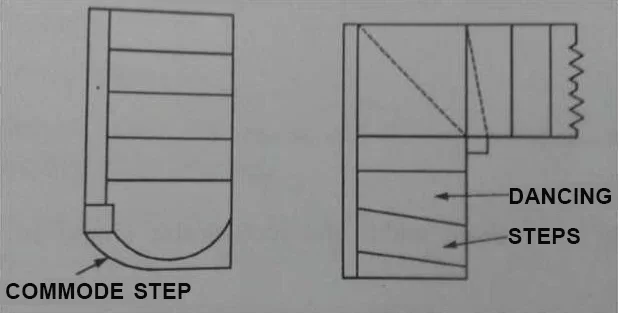
vi) Dancing steps or Balancing steps
- Dancing steps are the winders which do not radiate from a common centre.
vii) Winders
- Winders are tapering steps, such as those which radiate from a point usually situated at the centre of a newel post.
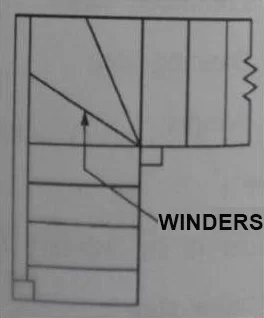
3) Classification of staircase
- Straight Staircase
- Turning Staircase
- Quarter Turn
- Half Turn (Dog-Legged & Open well Staircase)
- Three-Quarter Turn Staircase
- Bifurcated Staircase
- Continuous Staircase
- Circular Staircase
- Spiral Staircase
- Helical Staircase
i) Straight staircase
- If the space available for stair case is narrow and long, straight stairs may be provided.
- Such stairs are commonly used to give access to porch or as emergency exits to cinema halls.
- In this type all steps are in one direction.
- They may be provided in single flight or in two flights with landing between the two flights
Straight staircase
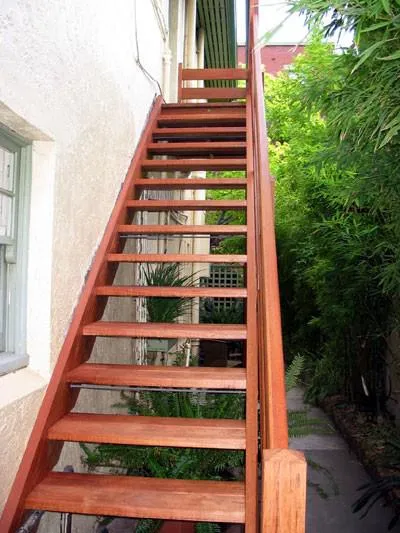
Quarter turn staircase
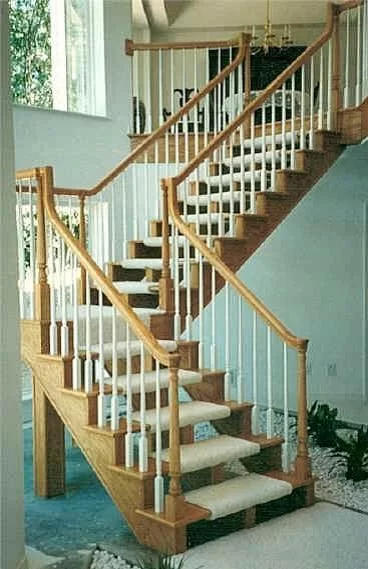
Dog-legged staircase
- It consists of two straight flights with 180° turn between the two.
- They are very commonly used to give access from floor to floor.
- Photograph shows the arrangement of steps in such stairs.

Open well or newel staircase
- It differs from dog legged stairs such that in this case there is 0.15 m to 1.0 m gap between the two adjacent flights.

Geometrical staircase
- This type of stair is similar to the open newel stair except that well formed between the two adjacent flights is curved.
- The hand rail provided is continuous.
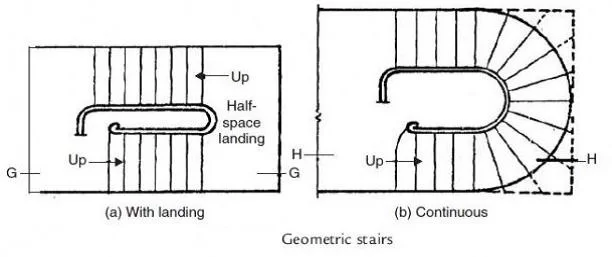
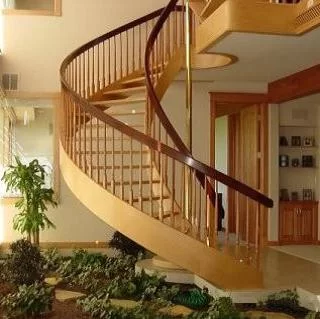
Bifurcated staircase
- Apart from dog legged and open newel type turns, stairs may turn in various forms.
- They depend upon the available space for stairs. Quarter turned, half turned with few steps in between and bifurcated stairs are some of such turned stairs.
- Figure shows a bifurcated stair.

ii) Spiral staircase
- These stairs are commonly used as emergency exits.
- It consists of a central post supporting a series of steps arranged in the form of a spiral.
- At the end of steps continuous hand rail is provided.
- Such stairs are provided where space available for stairs is very much limited.
- Figure shows a typical spiral stair. Cast iron, steel or R.C.C. is used for building these stairs.
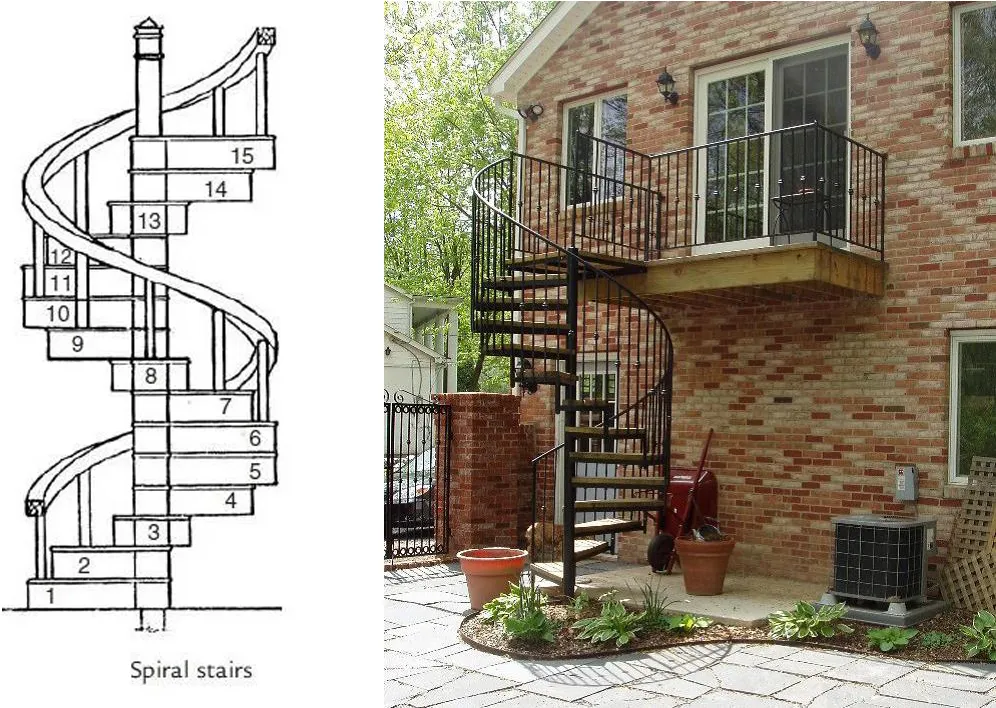
4) Guideline for staircase based on foreign standers
- Standard stride of an adult on a horizontal plane
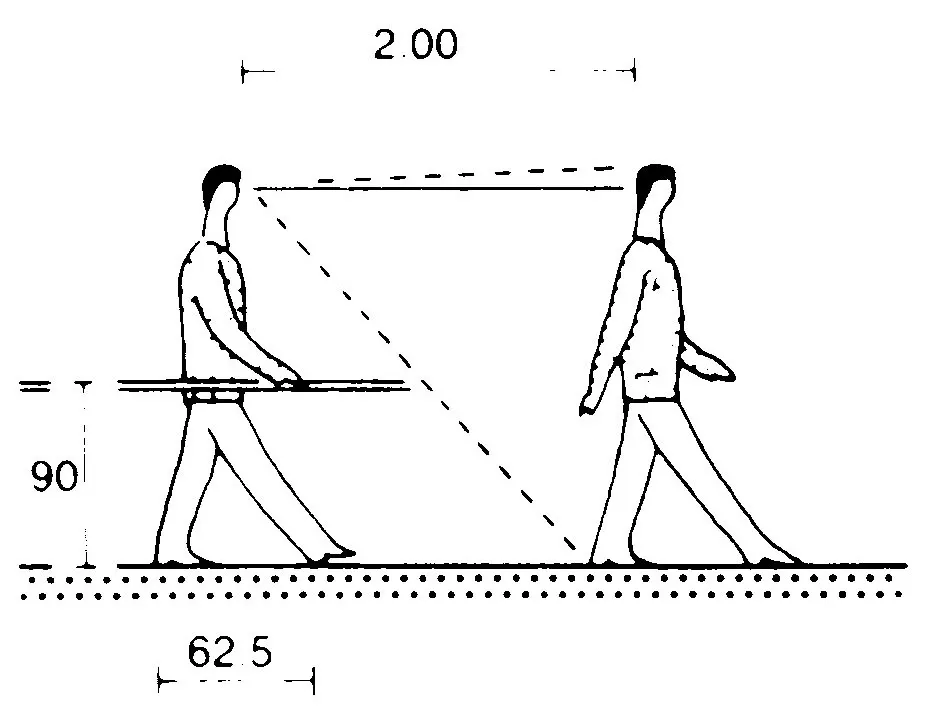
- Optimum rise – to – tread ratio = 1: 1.71 (Example: Riser = 150 mm. Then Tread (Going) = 150 x 1.71 = 256.5 mm.)

- Normal stair (1: 1.71); Landing ofter a max. of 18 steps. But according to NBC-2016 steps should be 12 Maximum.
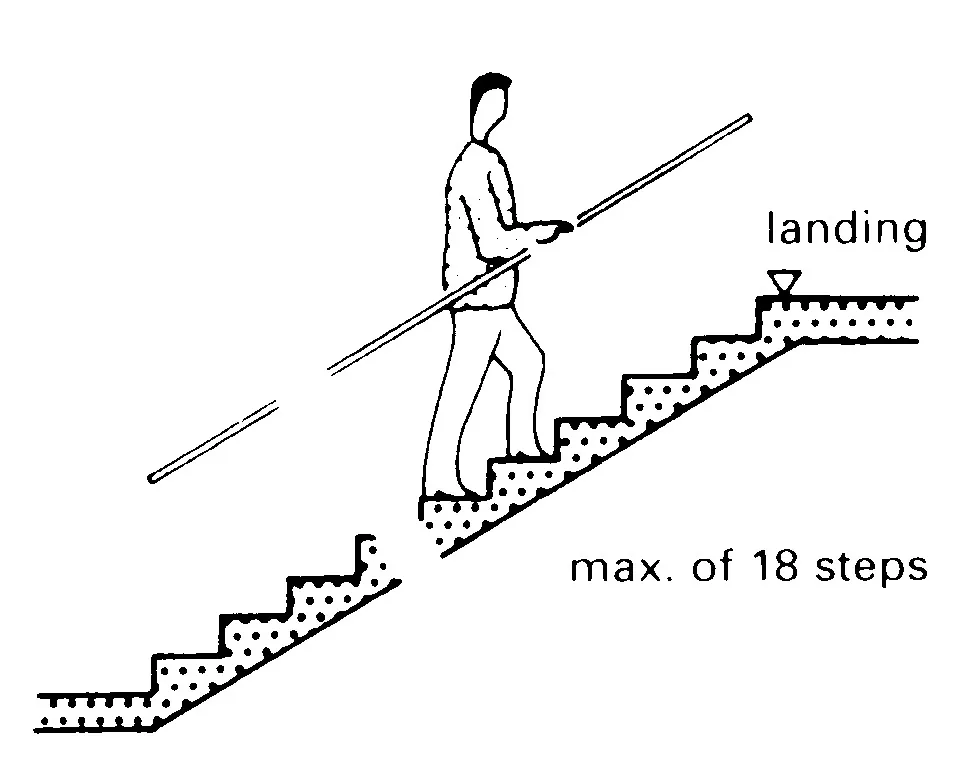
- Steps without handrail
- Handrails and barristers are not needed for less than five steps.

- Stairs with a rise of less than 1:4 do not require handrail.

- Superimposed stairs save space.

- If stairs are narrow or curved the distance of the line of walk to the outer string should be 350-400 mm.

- If stairs are straight and wide the distance of the line of wall to the handrails should be 550 mm.
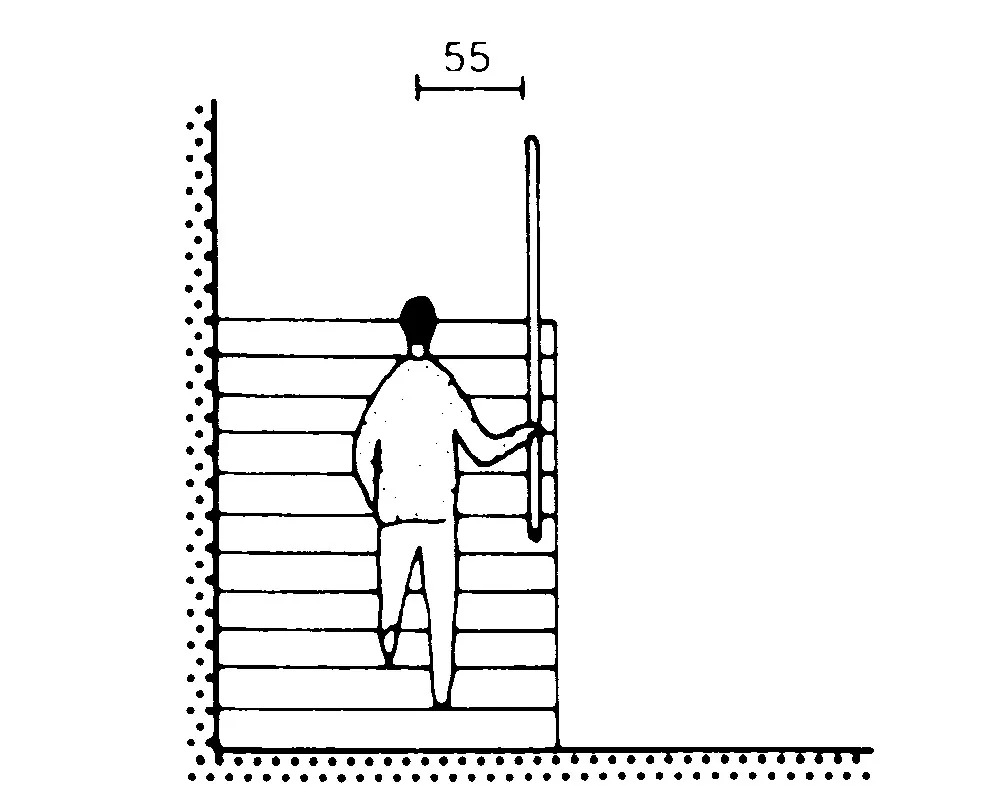
- Stair width allowing two people to pass.
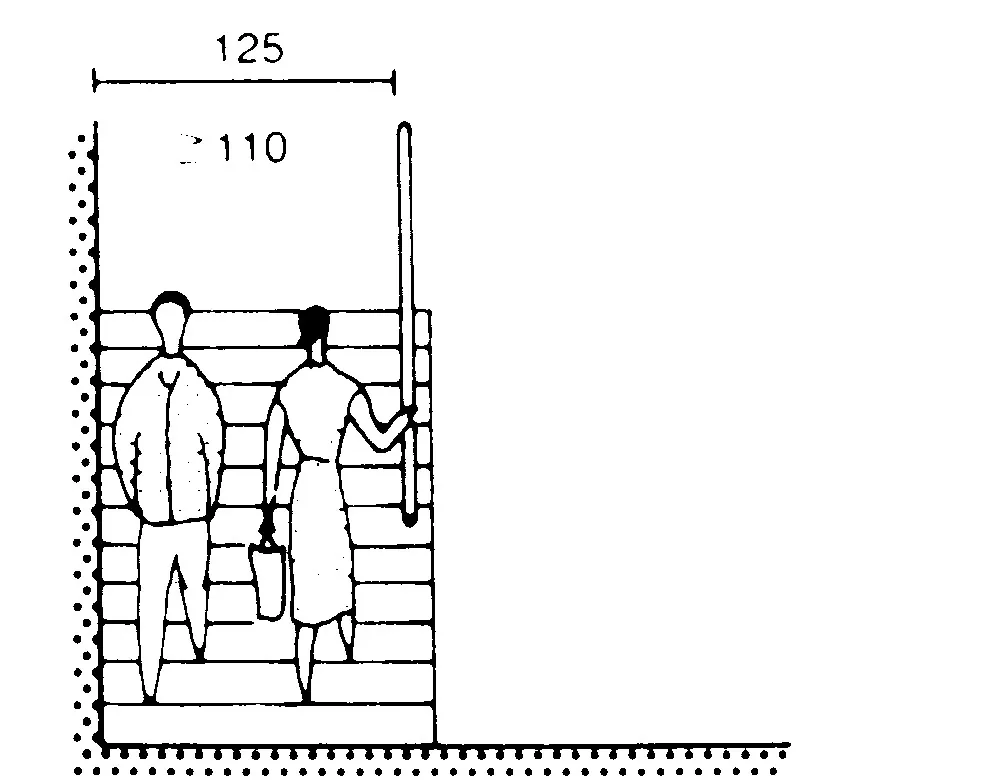
- Stair width allowing three people to meet and pass
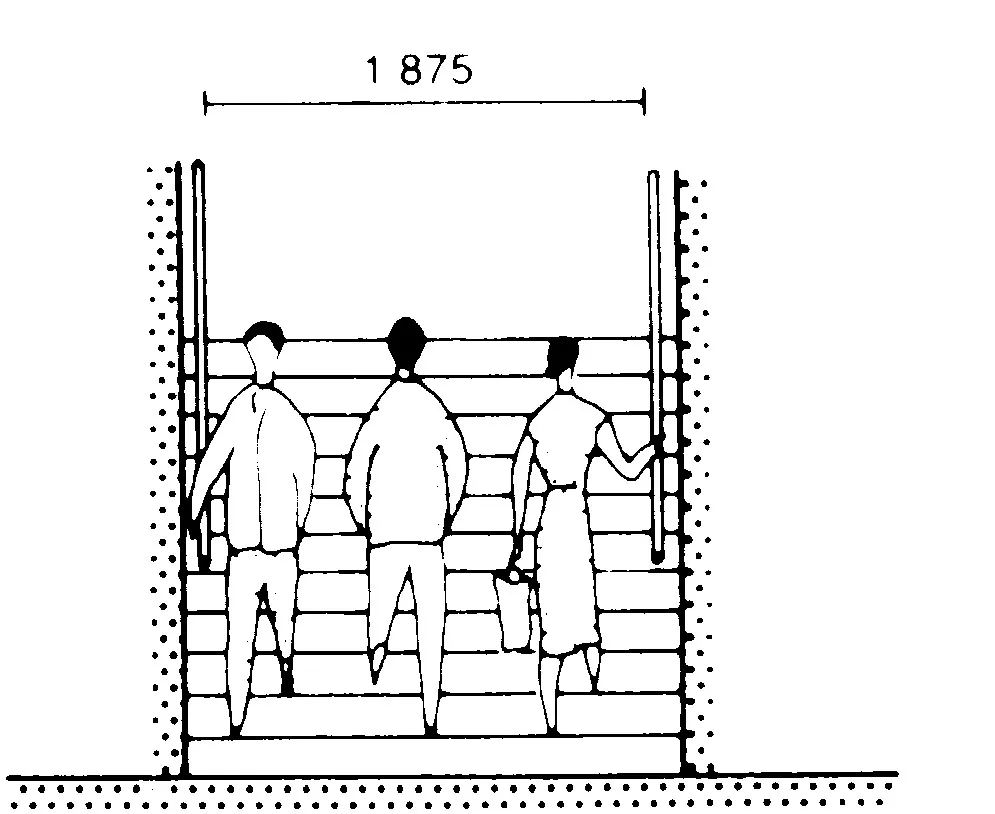
The experiences one has of ascending and descending stairs varies greatly with the stair design, for example there is a significant difference between an interior domestic design and a grand flight of entrance steps. Climbing stairs takes on average seven times as much energy as walking on the flat.
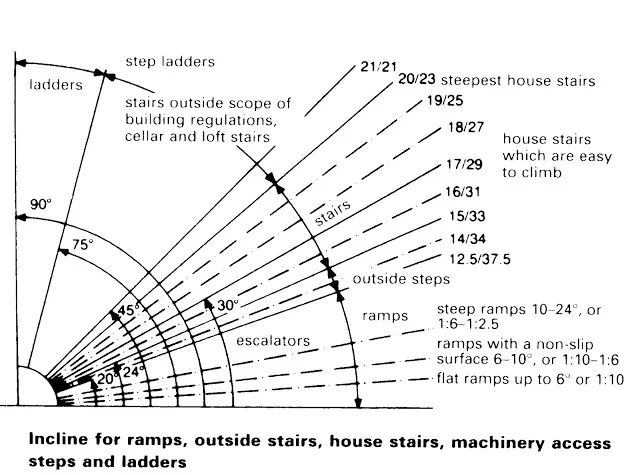
- Step profiles – To avoid marking risers with shoe polish from heels, use recessed profiles which have longer goings.

- Handrail profiles

5) Guideline for staircase based on indian standers
The requirements of number of staircases shall supplement the requirement of different occupancies in the building
All buildings, as mentioned in below paragraph, shall have a minimum of two staircases unless otherwise mentioned specifically in the provisions.
All high-rise buildings: and special buildings, those are mentioned below,
1) hotel, educational, institutional, business, mercantile, industrial, storage, hazardous and mixed occupancies, where any of these buildings have floor area more than 500 m2 on any one or more floors.
2) educational buildings having height 9 m and above.
3) institutional buildings having height 9 m and above.
4) all assembly buildings.
5) buildings, having area more than 300 m2 of incidental assembly occupancy on any floor; and
6) buildings with two basements or more, or with one basement of area more than 500 m2.
Note – The owner of the building and parties to agreement, may however, decide to apply the provisions of this Part to buildings other than those given above.
The actual number of staircases shall comply with the requirement of a of (Number of exits).
All exit staircases shall discharge, at the level of exit discharge, to the exit discharge, either,
- a) directly, or
- b) through an exit passageway, or
- c) through a large lobby.
At least 50 percent of the staircases shall discharge as per (a) and/or (b) above.
The minimum width of tread without nosing shall be 250 mm for staircase of residential buildings. This shall be minimum 300 mm for assembly, hotels, educational, institutional, business and other buildings. The treads shall be constructed and maintained in a manner to prevent slipping. The maximum height of riser shall be 190 mm for staircase of residential buildings (A-2) and 150 mm for other buildings.
The number of risers shall be limited to 12 per flight.
The staircases may be internal staircases or external staircases.
i) Internal staircases
The internal staircases may be constructed with an external wall, or otherwise, and shall comply with the following:
- Internal stairs shall be constructed of non- combustible materials throughout, and shall have fire resistant rating of minimum 120 min.
- A staircase shall not be arranged round a lift shaft.
- Exits shall not be used as a portion of a supply, return or exhaust air system serving adjoining areas. Any opening(s) shall not be permitted in walls or in doors, separating exits from adjoining areas.
- No flue chimney, electromechanical equipment, air conditioning units, gas piping or electrical panels shall be allowed in the stairway.
- Notwithstanding the detailed provision for exits in accordance with General Exit Requirements and Occupant Load, the following minimum width shall be provided for staircases for respective occupancies:
- Residential (A-2): 1.00 m
Note – For row housing with 2 storeys, the minimum width shall be 0.75 m.
- Residential (A-1, A-3 and A-4) = 1.25 m
- Residential hotel (A-5 and A-6) = 1.50 m
- Assembly = 2.00 m
Note – The width of stairs may be accepted to be 1.50 m in case of assembly occupancy having less than 150 persons.
- Educational = 1.50 m
- Institutional = 2.00 m
- All other occupancies = 1.50 m
- A handrail shall be provided on one side of the staircase of width less than 1500 mm, and on both sides of the staircase of width 1500 mm and more. The projection of handrail(s) in the staircase width shall not be more than 115 mm.
- Handrails may project inside the measured width by not more than 90 mm.
The design of staircase shall also take into account the following:
- The minimum headroom in a passage under the landing of a staircase and under the staircase shall be 2.2 m
- Access to exit staircase shall be through a fire door of a minimum 120 min fire resistance rating.
- No living space, store or other fire risk shall open directly into staircases.
- The exit (including staircases) shall be continuous from refuge floors or terrace level, as applicable, to the level of exit discharge.
- No electrical shafts/air conditioning ducts or gas pipes, etc, shall pass through or open in the staircases.
- Lifts shall not open in staircase.
- No combustible material shall be used for decoration/wall paneling in the staircase.
- Beams/columns and other building features shall not reduce the head room/ width of the staircase.
- The floor indication board, indicating the location/designated number of staircases, respective floor number and direction to exit discharge shall be placed inside the staircase, on the wall nearest to the fire door. It shall be of size not less than 300 mm × 200 mm as shown in figure.
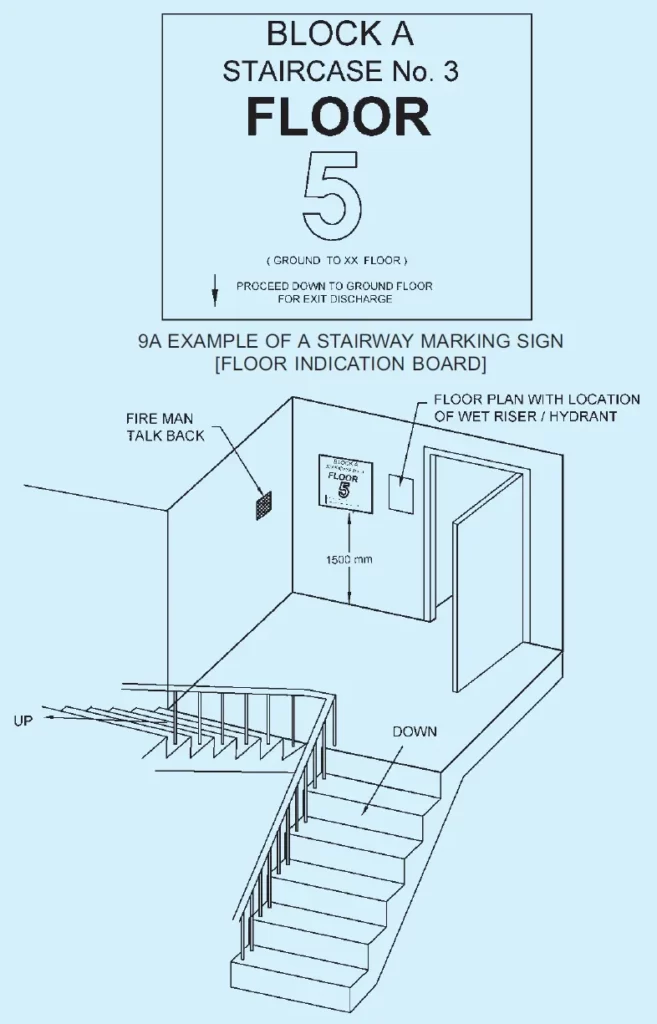
Note – Block/Wing/Building name is to be project specific. Staircase shown as 3 is intending to show the number assigned to the staircase. All exits preferably to be assigned with number/identification enabling occupants/fire man to declare location/position.
- Individual floors shall be prominently indicated on the wall outside the staircase and facing it.
- All staircases shall terminate at the level of exit discharge. The access to the basement shall be by a separate staircase.
- Scissors type staircases shall not be treated as part of exit.
ii) Curved stairs
Curved stairs shall not be treated as part means of egress. However, these may be used as part of exit access provided the depth of tread is not less than 280 mm at a point 350 mm from the narrower end of the tread and the smallest radius is not less than twice the stair width.
iii) External staircases
The external staircases are the staircases provided on the external wall/facade, and shall comply with the following:
- External stairs shall always be kept in sound and usable condition.
- All external stairs shall be directly connected to the ground.
- Entrance to the external stairs shall be separate and remote from the internal staircase.
- Where an external staircase is provided, it shall be ensured that the use of it at the time of fire is not prejudiced by smoke and flame from openings (for example, windows, doors) in the external face of the building. Care shall be taken to ensure that no external wall or window opening opens on to or close to an external stair. If such openings exist within 3 m from an external staircase, they shall be protected with fire rated doors/window assemblies with rating of at least 60 min as shown in figure.

- The external stairs shall be constructed of non-combustible materials, and any doorway leading to it shall have minimum 120 min fire resistance.
- No external staircase shall be inclined at an angle greater than 45° from the horizontal.
- External stairs shall have straight flight not less than 1500 mm wide.
- Handrails, to be provided on both sides, shall be of a height not less than 1000 mm and not exceeding 1200 mm. There shall be provisions of balusters with maximum gap of 150 mm.
- The use of spiral staircase shall be limited to low occupant load and to a building not exceeding 9 m in height. A spiral staircase shall be not less than 1500 mm in diameter and shall be designed to give adequate headroom.
By considering these and other factors, architects can design staircases that are both functional and aesthetically pleasing, and that enhance the overall design of the building.
Thanks a lot and I have learned a lot 🫡